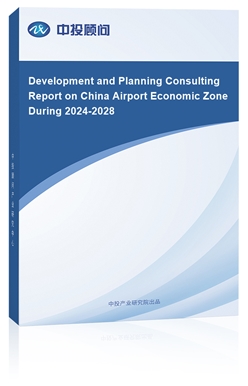
首次出版:最新修订:November 2018交付方式:特快专递(2-3天送达)
报告属性:共187页、6.5万字、35个图表下载目录 版权声明
定购电话:0755-82571522、82571566、400-008-1522
24小时服务热线:138 0270 8576 定制报告
| 版本 | 在线版 | 电子版+印刷版 | 在线报告库(超1000份报告)全库 |
|---|---|---|---|
| 优惠价 | RMB 6800 | RMB 7800 | RMB 9800 |
| 原价 | RMB 9600 | RMB 9800 | - |
联系电话: 400 008 0586; 0755-82571568
微信扫码: 
Chapter I: Relevant Summary of Airport Economic Zone
1.1: Concept Definitions of Airport Economic Zone
1.1.1: Concept Analysis of Airport Economy
1.1.2: Connotation of Airport Economic Zone
1.1.3: Features of Airport Economic Zone
1.2: Industry Classification and Characteristics of Airport Economic Zone
1.2.1: Overall Situation
1.2.2: Airport Service Industry
1.2.3: Aviation Logistics Industry
1.2.4: High-tech Industry
1.2.5: High Value-Added Manufacturing Industry
1.2.6: Exhibition Industry
1.2.7: Leisure Industry
Chapter II: 2016-2018 Comprehensive Analysis of Airport Economic Zone At Home and Abroad
2.1: Development Analysis of International Airport Economic Zone
2.1.1: Development Progress
2.1.2: Main Types
2.1.3: Development Mode
2.1.4: Development Tendency
2.2: Development Comprehensive Analysis of China Airport Economic Zone
2.2.1: Development Process Analysis
2.2.2: Analysis of Development Characteristics
2.2.3: Regional Distribution Status
2.2.4: Regional Development Comparison
2.2.5: Analysis of Development Mode
2.3: Analysis of China Airport Economic Policy Development
2.3.1: Airspace Management Reform Status
2.3.2: Guiding Opinions on Construction of Airport Economy Demonstration Zone
2.3.3: Layout Planning of Civil Airports
2.4: Development Problems and Countermeasure Analysis of Airport Economic Zone
2.4.1: Planning & Layout Problems
2.4.2: Major Constraints
2.4.3: Innovation System Strategy
2.4.4: Core Competiveness Enhancement Strategy
2.5: Development Tendency Analysis of China Airport Economic Zone
2.5.1: Development Tendency Analysis
2.5.2: The“13th Five-Year” Development Prospects
Chapter III: Industry Analysis of Key Layout of Airport Economic Zone during 2016-2018
3.1: Airport Services Industry
3.1.1: Analysis of Airport Catering Industry
3.1.2: Airport Retail Industry Analysis
3.2: Aviation Logistics Industry
3.2.1: Industry Development Status
3.2.2: Development Proposals and Measures
3.3: High Value-Added Industries
3.3.1: Analysis of Equipment Manufacturing Industry
3.3.2: Apparel Industry Analysis
3.4: Exhibition Industry
3.4.1: Industry Development Status
3.4.2: Industry Development Prospect
3.5: Leisure Tourism Industry
Chapter IV: Economic Zone Development Analysis of Partial Major Areas during 2016-2018
4.1: Beijing
4.1.1: Progress of Regional Construction
4.1.2: Industrial Spatial Layout
4.1.3: Strategic Development Plan
4.2: Zhengzhou City
4.2.1: Industry Development Policy
4.2.2: Market Development Potential
4.3: Urumqi City
4.3.1: Industrial Strategic Positioning
4.3.2: Spatial Layout Strategy
4.3.3: Development Risk Early Warning
4.4: Qingdao City
4.4.1: Analysis on Development Characteristics
4.4.2: Industrial Development Ideas
4.4.3: Industry Development Plan
4.5: Hunan Province
4.5.1: Development Status Analysis
4.5.2: Industrial Development Planning
4.5.3: Industrial Development Priorities
4.5.4: Industry Development Prospect
Chapter V: Planning, Layout and Operation Analysis of Airport Economic Zones
5.1: The Planning Framework of China Airport Economic Zones
5.1.1: Planning Purpose
5.1.2: Planning Research Contents
5.2: Spatial Layout Strategy of Airport Economic Zone
5.2.1: Overall Structure and Layout Mode
5.2.2: Airport Core Area Layout Strategy
5.2.3: Layout Strategy of Control Area around Airports
5.2.4: Layout Strategy of Non-construction Area around Airport
5.2.5: Layout Strategy of Areas Close to Airports
5.2.6: Layout Strategy of Peripheral Radiating & Driving Area
5.3: Development Mode Selection of Airport Economic Zone
5.3.1: Land Development Mode
5.3.2: Development Path Mode
5.3.3: Influence Modes from Airport Dominant Perspective
5.4: Industry Selection Ideas of Airport Economic Zone
5.4.1: A Vision Based on Integration of Internationalization and Localization
5.4.2: Influential Factors Based on the Development of Airport Economic Zone
Chapter VI: Typical Cases Analysis of Airport Economic Zones at Home and Abroad During 2016-2018
6.1: Analysis on Successful Cases of Foreign Airport Economic Zones
6.1.1: Ireland Shannon Airport Free Zone
6.1.2: Airport Aviation City of Netherlands Amsterdam Airport
6.1.3: America Memphis Airport Economic Zone
6.1.4: Free Economic Zone of South Korea Inchon Airport
6.2: Successful Case Analysis of China Airport Economic Zone
6.2.1: Beijing Shunyi Airport Economic Zone
6.2.2: Chongqing Airport Economy Demonstration Zone
6.2.3: Shanghai Hongqiao Airport Economic Demonstration Zone
6.2.4: Guangzhou Airport Economic Demonstration Zone
Chapter VII: Analysis on Enterprise Development and Operation of Airport Economic Zone During 2016-2018
7.1: Beijing Airport High-Tech Park Co., Ltd.
7.1.1: General Development Situation of The Enterprise
7.1.2: Management Benefit Analysis
7.2: China Fortune Land Development Co., Ltd.
7.2.1: General Development Situation of the Enterprise
7.2.2: Airport Economy Business
7.2.3: Management Benefit Analysis
7.3: Yuanxiang (Xiamen) International Airport Co., Ltd.
7.3.1: General Development Situation of the Enterprise
7.3.2: Management Benefit Analysis
7.4: HNA Group Co., Ltd. HNA Group Co., Ltd.
7.4.1: General Development Situation of Enterprise
7.4.2: Business Cooperation Trends
Chapter VIII: Government Positioning and Behavior Analysis in The Development of Airport Economic Zones
8.1: The Specific Functions of Government in the Zone Planning
8.1.1: Government Planning
8.1.2: Government Coordination
8.1.3: Government Supervision
8.1.4: Government Service
8.2: Behavior Analysis of Government Policy in the Development of Airport Economic Zone
8.2.1: Insufficient Supportive Policy
8.2.2: The Exertion of Leading Role of Government
8.2.3: Policy Support Guarantee Suggestions
8.3: The Function Positioning and Roles of Local Government in the Construction of Airport Industry Cluster
8.3.1: The Function Positioning of Local Government
8.3.2: Analysis on the Role of Local Government
Airport Economic Zone refers to the economic area formed around the airport, relying on the comprehensive advantages of large hub airports to develop an industry cluster with obvious aviation orientation, which is a dual-functioned combination of the traditional airport area and economic development zone. According to the special rules of the world economic development trend and the development of Airport Economic Zone, the industrial structure of Airport Economic Zone layout should focus on the airport service industry, aerospace industry, logistics industry, high-tech industry, exhibition and conference industry, tourism and leisure industry, and the high value-added manufacturing industry characterized by “short, small, light and thin".
The Twenty-first Century is an era of air transportation, and the airport economy highlighting the airport will certainly become the main force to promote a new round of growth in the global economy. With the rapid change of the industrial structure, product form and industrial organizational structure within the global scope, the position of Airport Economic Zone in regional economic structure has become increasingly prominent, which, as a new economic form, has gradually become a new economic growth pole of the urban economy.
In recent years, China Airport Economic Zone has obtained relatively rapid development. On one hand, it is benefiting from the introduction of the aerotropolis concept; and on the other hand, it has a direct relationship with the current prevalence of real estate economy. At present, China has initially formed a basic framework, which forms a airport economic zone center based on hub airports in Beijing, Shanghai and Guangzhou, takes the characterized airport economic zones in Chengdu, Chongqing, Xi'an, Shenzhen, Wuhan, Tianjin, Qingdao and other provincial capital cities or important cities as the backbone, and follows the trend to develop airport economy plans for the other cities successively.
As of May 2017, there were ten airport economic demonstration zones in China. At the beginning of 2017, Shanghai Hongqiao Airport Economic Demonstration Zone, Guangzhou Airport Economic Demonstration Zone were approved; Chengdu Airport Economic Demonstration Zone was approved in March, and in May, the airport economic demonstration zones in Changsha, Guiyang, and Hangzhou were approved respectively – within 5 months period, the quantity doubled. The attention paid on airport economy is unprecedentedly increasing.
Seeing from the development process of airport economy at home and abroad and successful cases of Airport Economic Zone construction, airport is a kind of resource and advantage. Therefore, the government should fully take advantage of these resources, and provide a good external environment for employment, industrial development, business and residence, so as to promote the development of local economy. Airport Economic Zone developed by any local government must be practical and realistic, construction plan of which should comply with the local economic development level and its own ability.
The airport economy is characterized by extroversion and high-end, and complies with the future rule of economic development and the national economic structure adjustment strategic direction. There are reasons to believe that this new economic form will take off in the near future.
Development and Planning Consulting Report on China Airport Economic Zone During 2019-2023 released by China Investment Consulting (CIC) has Eight chapters, which first introduced the definition, classification, and then analyzed the overall situation and the industrial layout of China Airport Economic Zone, detailedly reported the analysis on regional conditions, planning & construction, spatial arrangement, successful cases of home and abroad, and operating conditions of key enterprises of China Airport Economic Zone, and finally analyzed the government functions and policy behaviors in the plan of the Airport Economic Zone in detail.
The data in this research report is mainly from the National Bureau of Statistics, Ministry of Commerce, Ministry of Finance, Civil Aviation Administration, CIC Industrial Research Center, CIC Market Research Center and key journals at home and abroad, etc., which is authoritative, detailed and rich. Meanwhile, scientific prediction on the basis of industrial core development indexes has been carried out through professional analysis prediction model. This report is an important reference tool for you to track the latest development trend of Airport Economic Zone, prepare industry planning, and develop industrial policies and investment strategies.